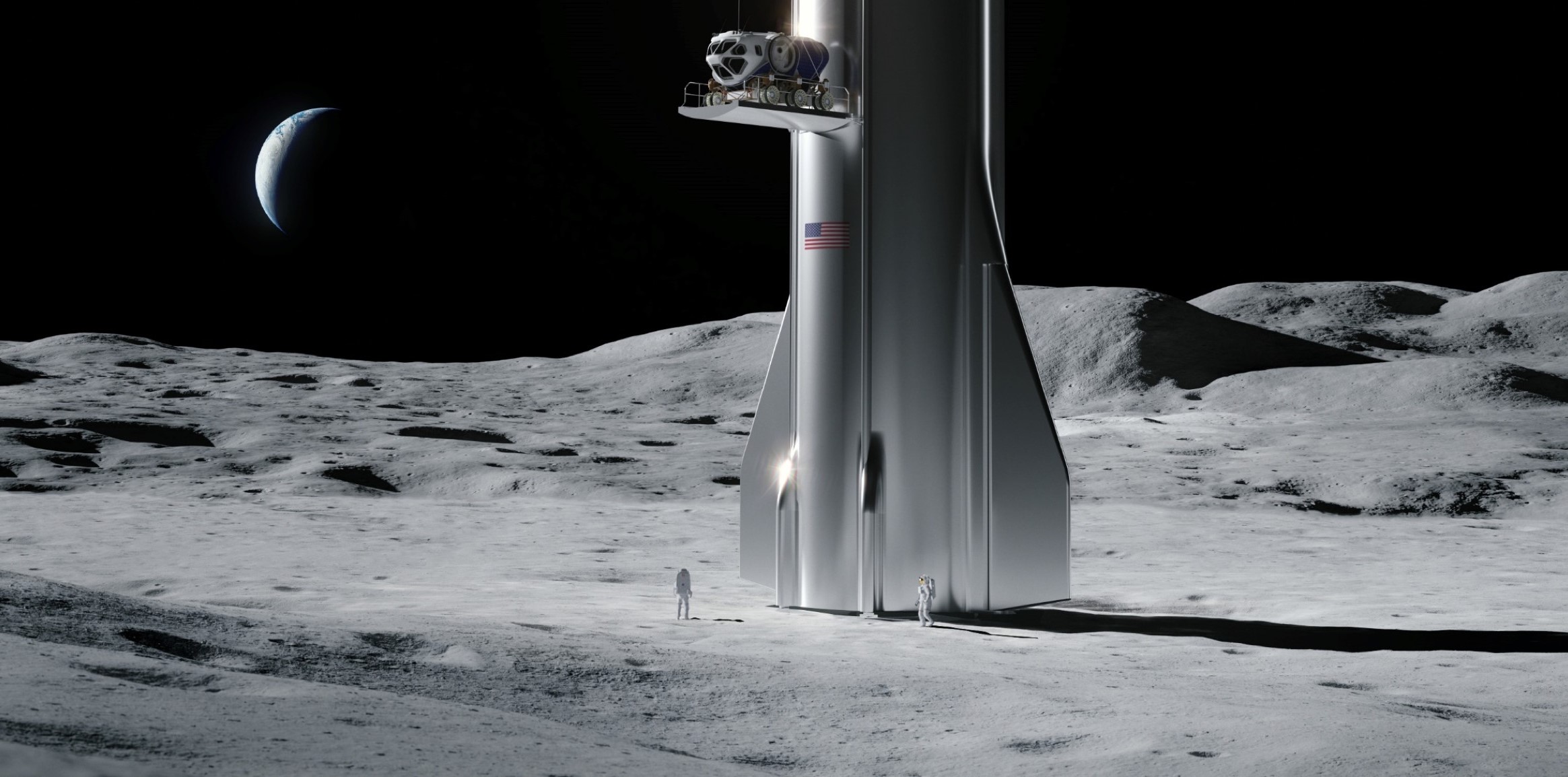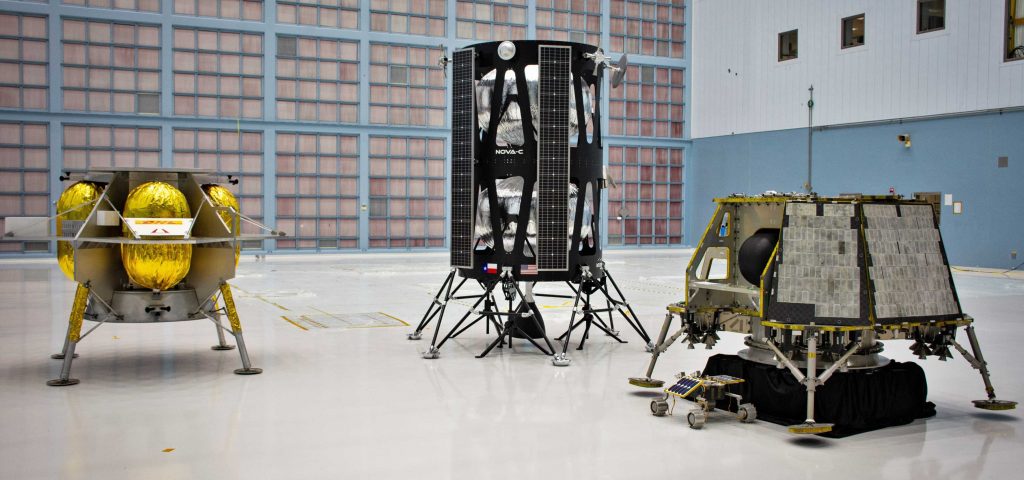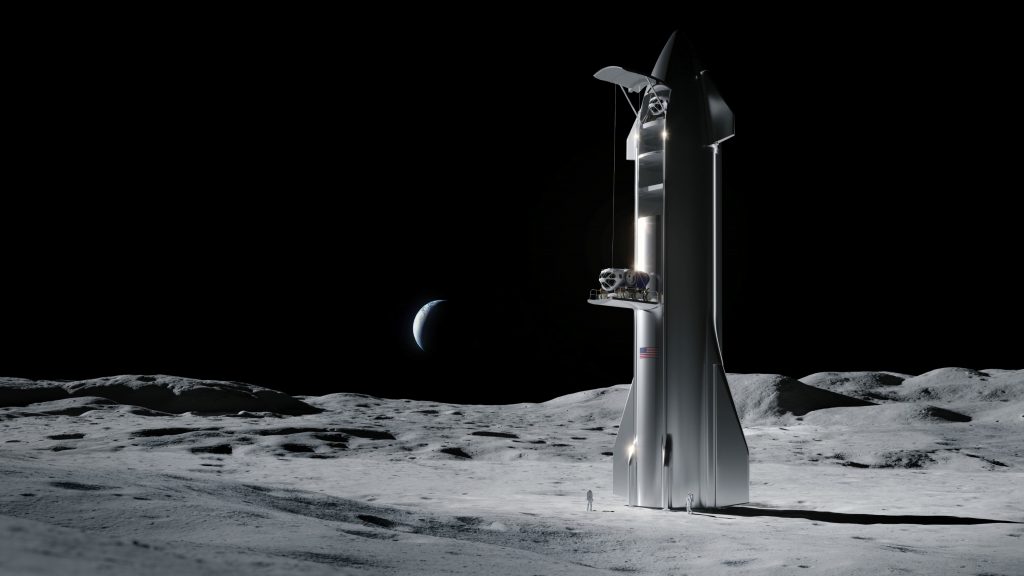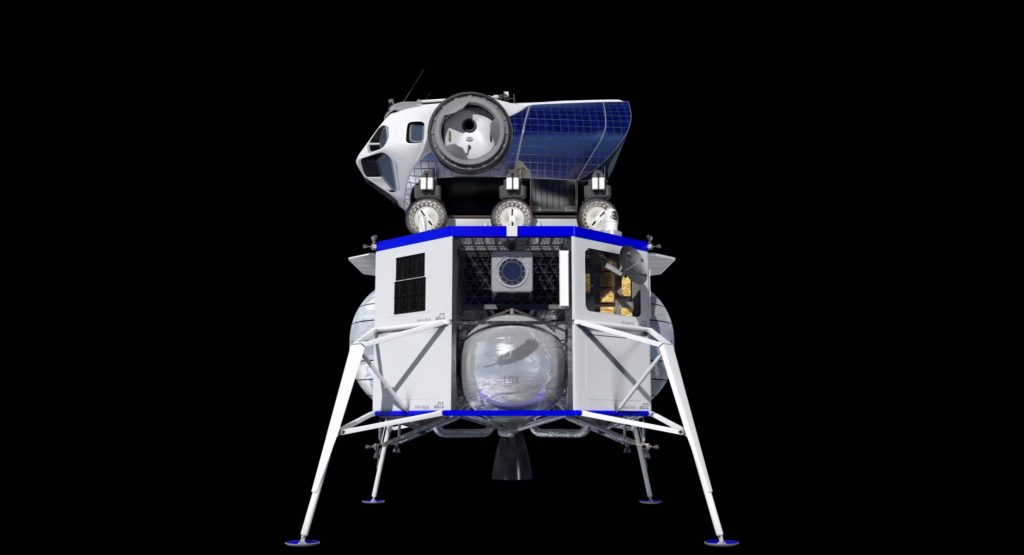

News
SpaceX’s Starship to spar with Blue Origin for NASA Moon landing contracts
On November 18th, NASA announced that it had added commercial Moon lander offerings from SpaceX, Blue Origin, Sierra Nevada Corporation, and others to a pool of companies that will be able to compete to affordably deliver cargo to the surface of the Moon. With this latest addition of landers, competition could get very interesting, very quickly.
In November 2018, NASA revealed a big step forward in its plans to kickstart robotic exploration and utilization of the Moon, announcing nine new partners in its Commercial Lunar Payload Services (CLPS) initiative. Designed first and foremost to encourage the commercial development of unprecedentedly affordable Moon landers, the program’s first nine partners included Lockheed Martin, Astrobotic, Intuitive Machines, Masten Space, Orbit Beyond, and several others.
In May 2019, NASA announced the next step, contracting with three of those nine aforementioned providers to bring their proposed Moon landers to fruition and attempt their first lunar landings. Orbit Beyond dropped out shortly after but Astrobotic and Intuitive Machines continue to work towards that goal and aim to attempt the first Moon landings with their respective Peregrine and Nova-C spacecraft no earlier than (NET) July 2021. Intuitive Machines has contracted a SpaceX Falcon 9 for its first Nova-C Moon launch, while Astrobotic side with the very first launch of United Launch Alliance’s (ULA) next-generation Vulcan rocket.

Generally speaking, the landers offered by the first nine CLPS partners were on the smaller side of the spectrum, capable of delivering around 50-100 kg (100-200 lb) of useful cargo to the surface of the Moon with launch masses around 1500-3000 kg (3300-6600 lb). On November 18th, NASA announced that a second group of partners would be added to the competitive ‘pool’ of CLPS-eligible Moon landers, all of which can technically compete to land a range of NASA payloads on the Moon. The new five are Ceres Robotics, Tyvak Nano-Satellite Systems, Sierra Nevada Corporation, Blue Origin, and SpaceX.
Next to nothing is known about Tyvak’s or Ceres Robotics’ apparently proposed landers, but a render of SNC’s Moon lander concept shares some obvious similarities with its Dream Chaser spacecraft and expendable power and propulsion module, implying that it’s likely on the larger side. Blue Origin and SpaceX, of course, proposed their Blue Moon and Starship spacecraft.


As a 100%-speculative guess, Ceres and Tyvak’s landers are likely in the same ~100 kg-class range as the nine CLPS providers selected before it, while Sierra Nevada’s lander concept is probably closer to 500 kg (1100 lb). According to Blue Origin, it’s recently-updated Blue Moon lander is designed to deliver up to 4500 kg (9900 lb) to the lunar surface and is expected to attempt its first Moon landing no earlier than 2024.
Unsurprisingly, SpaceX’s Starship blows all 13 other lander proposals out of the water and, in the context of the CLPS program, is a bit like bringing a Gatling gun to a paintball match. According to SpaceX, a fully-refueled Starship should be able to land 100 metric tons (220,000 lb) of cargo on the Moon, although it’s unclear if that would allow the Starship to return to Earth.

In simpler terms, there is just no chance whatsoever that the practical scope of NASA’s CLPS program could possibly warrant more than a few metric tons delivered to the surface of the Moon. NASA as a whole doesn’t have the budget needed to build useful several-dozen-ton spacecraft or experiments, let alone CLPS. In that sense, the real question to ask is what could Starship manage if the useful payloads it needs to deliver are no more than a few metric tons?
Assuming SpaceX’s technical know-how is mature enough to allow Starship to preserve cryogenic propellant for weeks or months after launch, it’s entirely conceivable that a Moon launch with, say, 10 tons of cargo could be achieved with just one or two in-orbit refuelings, all while leaving that Starship enough margin to safely return to Earth. Given that NASA awarded Intuitive Machines and Astrobotic approximately $80M apiece to land 50-100 kg on the Moon, it’s far too easy to imagine SpaceX quoting a similar price to deliver 10+ tons to the Moon by enabling full Starship reuse.
All things considered, politics still looms in the distance and there is just as much of a chance that SpaceX (and maybe even Blue Origin) will be passed over by CLPS when the time comes to award the next round of Moon delivery contracts. Still, the odds of something far out of the ordinary happening are much higher with a program like CLPS. Stay tuned!
Check out Teslarati’s Marketplace! We offer Tesla accessories, including for the Tesla Cybertruck and Tesla Model 3.
Lifestyle
EV fans urge Tesla to acquire Unplugged Performance for edge in fleet and security industry
Unplugged Performance has built a name for itself by producing performance upgrades for Tesla vehicles.

A growing number of Tesla enthusiasts and longtime community voices are calling on the electric vehicle maker to acquire Unplugged Performance, a California-based aftermarket company best known for tuning Tesla vehicles and developing specialized government fleet solutions under its UP.FIT division.
The idea was once considered a niche proposal among EV fans, but it is now gaining serious attention not just as a performance play but as a strategic move to deepen Tesla’s roots in the fleet and security industry.
A strategic fit
Unplugged Performance has built a name for itself by producing performance upgrades for Tesla vehicles, from track-optimized components to visual and aerodynamic upgrades. But in recent years, its UP.FIT division has pivoted toward a more functional future by outfitting Tesla vehicles like Model Ys for police, military, and government use.
That work has sparked growing calls for closer collaboration with Tesla, especially as the EV maker increasingly leans into autonomy, AI, and fleet services as core components of its next chapter.
“I posted this four years ago, but I think it’s more true now than ever,” wrote Whole Mars Catalog, a well-known Tesla investor and FSD Beta tester, on X. “Tesla should buy Unplugged. But not just as a Performance division. What they are doing with UP.FIT unlocks large government and commercial fleet purchases that can improve utilization.”
Tesla fans such as shareholder Sawyer Merritt echoed the sentiment, calling Unplugged a “great fit within Tesla.” adding, “They are literally located directly next to Tesla’s design studio in Hawthorne.”
Enabling the next wave
Supporters of the idea noted that integrating Unplugged into Tesla’s corporate structure could help accelerate adoption of autonomous technologies, particularly in government sectors. With UP.FIT patrol cars already in use across some U.S. police departments, Tesla fans envisioned a future where self-driving Teslas could potentially revolutionize law enforcement, search-and-rescue, and public service logistics.
“Just imagine how autonomous patrol cars could transform policing and bring us into a safer future,” the veteran FSD tester wrote.
The benefits could also extend to Tesla’s existing consumer base. “They also have some incredible products in the works that I think will appeal to many ordinary Tesla drivers — not just those looking for performance or mods. Stuff that’s so good it should have come straight from the design studio next door,” Whole Mars Catalog noted.
Unplugged Performance, founded in 2013, shares not just a product vision with Tesla, but also geography. Its Hawthorne headquarters sits directly adjacent to Tesla’s design studio, and the two companies have maintained a close working relationship over the years. The aftermarket firm has long positioned itself as a “mission-aligned” partner to Tesla.
In response to the recent calls for acquisition, Unplugged Performance acknowledged the groundswell of support from the community. “Our very existence is to support the Tesla mission with @UpfitTesla and @UnpluggedTesla,” Unplugged CEO Ben Schaffer posted on X. “We love working with Tesla and are grateful for the community’s support since 2013!”
News
Tesla debuts hands-free Grok AI with update 2025.26: What you need to know
All new Tesla vehicles delivered on or after July 12, 2025, will include Grok AI out of the box

Tesla has begun rolling out Grok, an in-car conversational AI assistant developed by xAI, to eligible vehicles starting July 12. The feature marks the most direct integration yet between Elon Musk’s artificial intelligence startup and Tesla’s consumer product lineup, offering drivers hands-free access to a chat-style companion while on the road.
Grok comes pre-installed on new vehicles
According to Tesla’s FAQ page for the feature, all new vehicles delivered on or after July 12, 2025, will include Grok AI out of the box. Owners of older vehicles may gain access through an over-the-air update, provided their vehicle meets a few hardware and software requirements.
Specifically, Grok is currently only supported on Tesla models equipped with an AMD infotainment processor and running vehicle software version 2025.26 and higher. Compatible models include the Model S, Model 3, Model X, Model Y, and Cybertruck. A Premium Connectivity subscription or active Wi-Fi connection is also required.
Tesla notes that additional vehicle compatibility may arrive in future software updates.
Grok’s features and limitations for now
Drivers can engage with Grok using the App Launcher or by pressing and holding the voice command button on the steering wheel. Grok is designed to answer questions and hold conversations using natural language, offering responses tailored to its chosen personality—ranging from “Storyteller” to the more eccentric “Unhinged.”
For fun, Tesla posted a demonstration of Grok likely running on “Unhinged” talking about what it would do to Optimus when they are on a date, much to the shock of the humanoid robot’s official social media account.
It should be noted, however, that Grok cannot currently issue commands to the vehicle itself, at least for now. Traditional voice commands for tasks like climate control, navigation, or media remain separate from Grok as of writing.
The feature is being released in Beta and does not require a Grok account or xAI subscription to activate, although that policy may change over time.
Grok privacy and in-car experience
Tesla emphasizes that interactions with Grok are securely processed by xAI and not linked to a user’s Tesla account or vehicle. Conversations remain anonymous unless a user signs into Grok separately to sync their history across devices.
Tesla has also begun promoting Grok directly on its official vehicle webpages, showcasing the feature as part of its in-car experience, further highlighting the company’s increasing focus on AI and infotainment features on its all-electric vehicles.
News
Tesla cleared in Canada EV rebate investigation
Tesla has been cleared in an investigation into the company’s staggering number of EV rebate claims in Canada in January.

Canadian officials have cleared Tesla following an investigation into a large number of claims submitted to the country’s electric vehicle (EV) rebates earlier this year.
Transport Canada has ruled that there was no evidence of fraud after Tesla submitted 8,653 EV rebate claims for the country’s Incentives for Zero-Emission Vehicles (iZEV) program, as detailed in a report on Friday from The Globe and Mail. Despite the huge number of claims, Canadian authorities have found that the figure represented vehicles that had been delivered prior to the submission deadline for the program.
According to Transport Minister Chrystia Freeland, the claims “were determined to legitimately represent cars sold before January 12,” which was the final day for OEMs to submit these claims before the government suspended the program.
Upon initial reporting of the Tesla claims submitted in January, it was estimated that they were valued at around $43 million. In March, Freeland and Transport Canada opened the investigation into Tesla, noting that they would be freezing the rebate payments until the claims were found to be valid.
READ MORE ON ELECTRIC VEHICLES: EVs getting cleaner more quickly than expected in Europe: study
Huw Williams, Canadian Automobile Dealers Association Public Affairs Director, accepted the results of the investigation, while also questioning how Tesla knew to submit the claims that weekend, just before the program ran out.
“I think there’s a larger question as to how Tesla knew to run those through on that weekend,” Williams said. “It doesn’t appear to me that we have an investigation into any communication between Transport Canada and Tesla, between officials who may have shared information inappropriately.”
Tesla sales have been down in Canada for the first half of this year, amidst turmoil between the country and the Trump administration’s tariffs. Although Elon Musk has since stepped back from his role with the administration, a number of companies and officials in Canada were calling for a boycott of Tesla’s vehicles earlier this year, due in part to his association with Trump.
-

 Elon Musk2 weeks ago
Elon Musk2 weeks agoTesla investors will be shocked by Jim Cramer’s latest assessment
-

 Elon Musk2 days ago
Elon Musk2 days agoxAI launches Grok 4 with new $300/month SuperGrok Heavy subscription
-

 Elon Musk5 days ago
Elon Musk5 days agoElon Musk confirms Grok 4 launch on July 9 with livestream event
-

 News1 week ago
News1 week agoTesla Model 3 ranks as the safest new car in Europe for 2025, per Euro NCAP tests
-

 Elon Musk2 weeks ago
Elon Musk2 weeks agoA Tesla just delivered itself to a customer autonomously, Elon Musk confirms
-

 Elon Musk1 week ago
Elon Musk1 week agoxAI’s Memphis data center receives air permit despite community criticism
-

 News2 weeks ago
News2 weeks agoXiaomi CEO congratulates Tesla on first FSD delivery: “We have to continue learning!”
-

 News2 weeks ago
News2 weeks agoTesla sees explosive sales growth in UK, Spain, and Netherlands in June

















